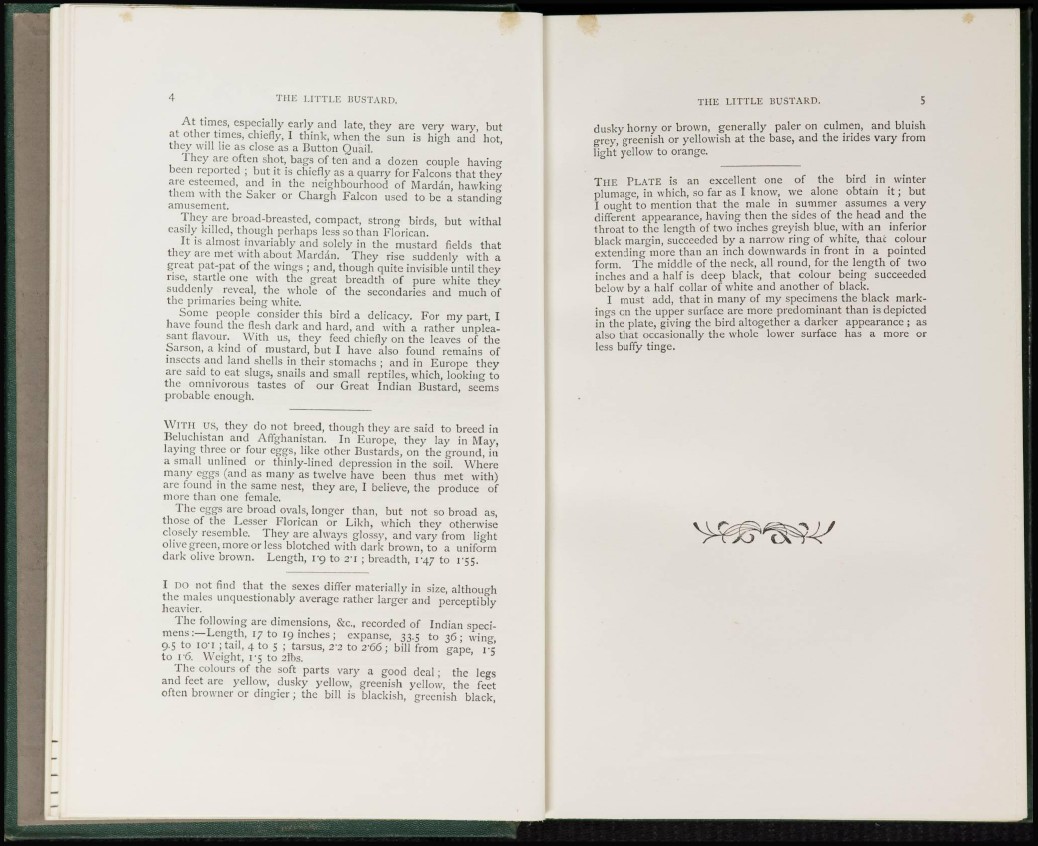
4 THE LITTLE BUSTARD.
At times, especially early and late, they are very wary, but
at other times, chiefly, I think, when the sun is high and hot,
they will lie as close as a Button Quail.
They are often shot, bags of ten and a dozen couple having
been reported ; but it is chiefly as a quarry for Falcons that they
are esteemed, and in the neighbourhood of Mardan, hawking
them with the Saker or Chargh Falcon used to be a standing
amusement.
They are broad-breasted, compact, strong birds, but withal
easily killed, though perhaps less so than Florican.
It is almost invariably and solely in the mustard fields that
they are met with about Mardan. They rise suddenly with a
great pat-pat of the wings ; and, though quite invisible until they
rise, startle one with the great breadth of pure white they
suddenly reveal, the whole of the secondaries and much of
the primaries being white.
Some people consider this bird a delicacy. For my part, I
have found the flesh dark and hard, and with a rather unpleasant
flavour. With us, they feed chiefly on the leaves of the
Sarson, a kind of mustard, but I have also found remains of
insects and land shells in their stomachs ; and in Europe they
are said to eat slugs, snails and small reptiles, which, looking to
the omnivorous tastes of our Great Indian Bustard, seems
probable enough.
W I T H US, they do not breed, though they are said to breed in
Beluchistan and Affghanistan. In Europe, they lay in May,
laying three or four eggs, like other Bustards, on the ground, in
a small unlincd or thinly-lined depression in the soil. Where
many eggs (and as many as twelve have been thus met with)
are found in the same nest, they arc, I believe, the produce of
more than one female.
The eggs are broad ovals, longer than, but not so broad as,
those of the Lesser Florican or Likh, which they otherwise
closely resemble. They are always glossy, and vary from light
olive green, more or less blotched with dark brown, to a uniform
dark olive brown. Length, vg to 2'i ; breadth, l'47 to 1-55.
I DO not find that the sexes differ materially in size, although
the males unquestionably average rather larger and perceptibly
heavier.
The following are dimensions, &c, recorded of Indian specimens
:—Length, 17 to 19 inches ; expanse, 33.5 to 36; wing,
9.5 to io'i ; tail, 4 to 5 ; tarsus, 2 ' 2 to 2'66 ; bill from gape, 1*5
to 16. Weight, 1-5 to 2 l h s.
The colours of the soft parts vary a good deal ; the legs
and feet are yellow, dusky yellow, greenish yellow, the feet
often browner or dingier; the bill is blackish, greenish black,
THE LITTLE BUSTARD. 5
dusky horny or brown, generally paler on culmen, and bluish
grey, greenish or yellowish at the base, and the irides vary from
light yellow to orange.
THE PLATE is an excellent one of the bird in winter
plumage, in which, so far as I know, we alone obtain i t ; but
I ought to mention that the male in summer assumes a very
different appearance, having then the sides of the head and the
throat to the length of two inches greyish blue, with an inferior
black margin, succeeded by a narrow ring of white, that colour
extending more than an inch downwards in front in a pointed
form. The middle of the neck, all round, for the length of two
inches and a half is deep black, that colour being succeeded
below by a half collar of white and another of black.
I must add, that in many of my specimens the black markings
on the upper surface are more predominant than is depicted
in the plate, giving the bird altogether a darker appearance ; as
also that occasionally the whole lower surface has a more or
less buffy tinge.